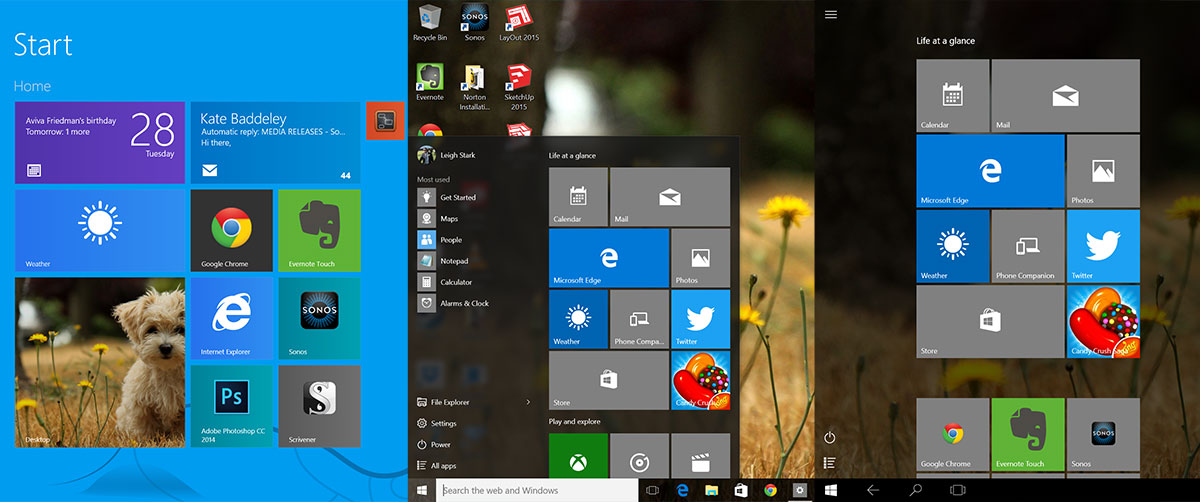Multitasking and virtual desktops
Control comes in all shapes and sizes, though much of the application control we have on an operating system is exerted when we decide to run several apps at once.
After all, what exactly is the point of having a powerful computer — even a moderately powerful one — when you have to use one app at a time.
That’s not the world we’re living in, people. Not by a long shot.
In Windows, you’ve always been able to load multiple applications at once, just like you can on Mac OS X, but with Windows 8, it felt like Microsoft put the brakes on that just a bit with a wonky side-by-side multi-tasking snap feature that had to be fixed in 8.1.
Windows 10 tries to fix that, and it does so depending on the mode you’re working in, so let’s go back to those two modes that are built into 10: desktop mode and tablet mode.
Tablet mode is worth covering first, because your multitasking is handled through a sleeker implementation of snapping two windows side by side.
With a touchscreen, you can press the right most icon in the left corner, the multitask icon.
This will provide all of your windows on a smaller view, and you can quickly jump into each one whenever you want.
That’s fine, but to multitask, you swipe down from the top frame and drag that application to one side, left or right.
Once you’ve done that, the side that was left vacant will show you the currently running apps, allowing you to select one and load it into place, changing the divider based on what you want.
Tested on the Microsoft Surface 3, we’ve only been able to get two apps running side-by-side, but we’re guessing a larger resolution display will yield more apps like it did on Windows 8.
Then there’s the desktop mode.
Desktop mode doesn’t run the same gesture controlled interface, so you can’t just swipe down to switch apps.
Rather, you rely on that same multitask icon found in practically the same place, the bottom left corner just after the search bar. Easy.
Press that and your apps will pop up in a handy multitasking view. This lets you jump into apps quickly.
Once you’re in one, drag the menu bar of that app with either a mouse gesture (click and hold) or a finger gesture (touch and drag) to one of the sides.
Again, the currently running apps will appear in the vacant spot, allowing you to pick and fill what goes in that spot.
Theoretically, this mode allows you to fill up apps not just in a side-by-side setting, but also in quadrants. We weren’t able to test that with the Surface 3, but we’ll be putting it through its paces on a larger screen later on to see if size and resolution is the barrier for this mode.
Desktop mode also comes with a bonus setting called “desktops”.
This is one of those things Mac users will be familiar with in the “spaces” feature, and it allows you to have applications run on virtual desktops in full screen, so if you don’t want apps running side-by-side, but you do want to switch between a fullscreen Mail app and a fullscreen Photoshop, you can have them running on different desktops, with the creation of these found in the multitask button.
App updates, and that blasted Windows app ecosystem
By now you’re probably familiar with how Windows 8 tried to get you to buy apps using the Windows 8 store, and if you tried that, you’re also probably aware how much of a disaster zone it was.
It wasn’t Microsoft’s best effort. Not by a long shot.
Fortunately, the big M has done some cleaning up here, with a clearer interface, larger banners, proper charts and category layouts, and a linking to music, movies, and TV shows, which seems like the first step to integrating Xbox’s media services with Windows 10.
But the app and games ecosystem is still pretty sub-par, and it’s not quite up to the strength that Mac OS X offers, or any of the mobile operating system, or even the app environments offered from things you download from the web or Steam.
The upside to the desktop and tablet modes being pretty much identical in the apps they run is that now your apps will load in windows if you need them in desktop mode, or full-screen for tablets, and this applies to everything.
Want to run Photoshop on a tablet? It loads in fullscreen. Want to load it in a window? You can do that in desktop and expand it to fullscreen after the fact.
The Windows app ecosystem is still there, still waiting for a killer app to be built with that new Windows-friendly design language, but you’re not forced to use it, and that’s awesome.













